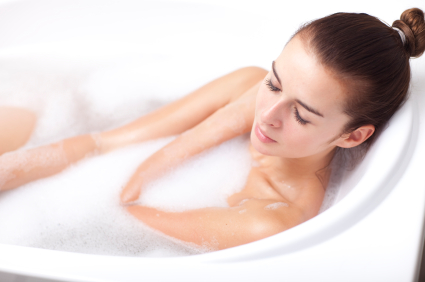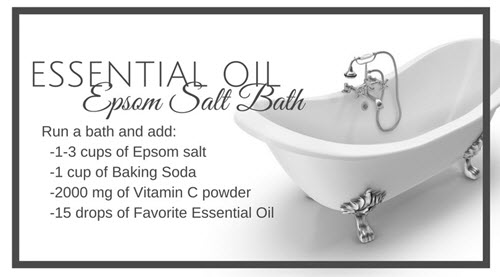How to Take Epic Epsom Salt Baths


For years, Epsom salt baths have been encouraged by several top natural health leaders. In my previous article on Epsom salt baths, I reviewed the science of why Epsom salt baths can help health. If you need a quick refresher, just remember these three points:
- Increases magnesium levels in the body, which is important for great health and sometimes hard to get via diet alone (even a real food diet).
- Increases sulfate levels in the body. Sulfate is needed for proper liver detox, which is a good idea in our ever toxic world.
- Lowers stress hormones. This has yet to be tested in studies, however those who’ve done an Epsom salt bath know it is a relaxing and calming ritual. For me, it’s not a huge logical jump to assume that sitting in a hot bath, breathing and thinking, without technology, will lower stress levels.
In general, the science on the health benefits of Epsom salt baths is nowhere conclusive or complete at this time. However, lack of proof is not proof against and with the low risk of side effects and the benefits possibly very high, I think it’s a great therapy to add to any natural health program.
Important Qualities of an Amazing Epsom Salt Experience
Most people think of taking Epsom salt baths in a bathtub. And that’s typically what I do. But just because you don’t have a bathtub doesn’t mean you have to skip this article. You can get many of the same benefits by soaking your feet in Epsom salts. In other words, anyone can find a plastic tub or bucket and take Epsom salt foot baths. No excuses, but from here on out I will assume you have access to some kind of tub of water to submerge your body in.
First, let’s talk about a few factors that will influence your Epsom salt bath experience.
- Temperature – The temperature of the bath or foot soak will affect the therapeutic effect of the bath. This has been my experience and it’s reported from many who practice regular bathing. The hotter the water, the more of an effect these baths seem to have. I usually draw water that is hot enough to sting as I ease in. My body seems to adapt pretty fast and heat is lost rapidly through most bathtubs, so if it’s too hot just wait a bit or add some cold water.
- Solution Concentration – I get all excited about making an Epsom salt bath because it takes me back to chemistry class. A bit of this and a bit of that and BOOM. Yep… I had fun in that class. Anyways, what I’m talking about here is how much Epsom salt to put into your bath, because this determines the strength of the soak. The more Epsom salt you dump in, the stronger the solution will be. And don’t forget about the size of the vessel you’re pouring the salt in. If you have an extra-large tub you will need more Epsom salt to create the same strength solution as someone with a standard size tub. And if you’re using a foot bath, you need much less.
- Environment – Part of the benefit of the Epsom salt bath is lowering stress hormones. So, the environment in which you take these baths is worth mentioning. If possible, make sure everyone is going to leave you alone… especially if you have kids. Let them know this is mommy time unless some life threatening problem arises. Later, I will talk more about this, but you can also enhance the environment using music, candles and essential oil scents.
- Raw Materials – Luckily it doesn’t appear that there is much variation in the Epsom salt market. I’ve tried a few brands and didn’t notice a difference in the results or quality of salt. My current favorite for price and value is this 19lb bag of Epsoak Epsom Salt (a steal if you have Amazon Prime shipping). There are plenty of Epsom salt blends in which the companies add in additional herbs or scents. I’ve tried a few and I’m not a fan. They tend to be priced really high and if you don’t like the blend strength (high/low) you can’t do much about it. Save your money and make your own.
- Water Quality – If you’re like me and will be relying on unfiltered city water, it’s likely you might want to take a few extra steps to improve the water quality. The first one is Ascorbic Acid (vitamin C powder). In this article, Chris Kresser breaks down why you want to remove chlorine and chloramine from your water. I use about 2000mg per bath. Next, you might test adding a ¼ to 1 cup of sodium bicarbonate (baking soda) to raise the pH of the water, which will possibly help to fight skin infections. I haven’t jumped into the rabbit hole of high pH water and health, but I do know from testing the baking soda that my skin is less red, so I keep using it.
- Time – How long are you going to soak? Well, it would appear from an informal survey of the internet, the time spent in the water should be anywhere from 10 to 40 minutes. The sweet spot for me is 20 minutes. 15 minutes seemed too short and 30+ felt the same as 20. So, my goal is always 20 minutes and if I’m really relaxed and enjoying myself I just turn the alarm off and stay soaking till I’m bored. That could be another 2 minutes or 10+, it just depends. I think there is some logic that staying in longer might help, but don’t make this a sticking point. Shoot for the minimum effective dose to get most of the benefits, which for me is around 20 minutes.
Okay, so to sum it up, to create an EPIC Epsom salt bath we should think about the following factors: water temperature, solution concentration, environment, raw materials, water quality, and time. Now, I’ll run through the steps you can follow to get started.
Creating an Epic Epsom Salt Bath Experience
Why do I keep saying Epic? Well, you could just dump Epsom salt in the bathtub and jump in. There’s really no right or wrong way here. But for me, that’s too basic and I like to take it up a few levels.
So, what takes a normal Epsom salt bath to Epic levels? A few of the ingredients listed below.
Water Enhancers – Ascorbic Acid and Baking Soda will help reduce skin irritation and, in my experience, actually help my skin look and feel better.
Essential Oils – Yes, these do have merits and for those who think they lack actual scientific facts let me clue you in on a few that do.

- Cypress Oil – Is great for activating natural killer (NK) cells, which are a very important part of the immune system (especially for tumor killing). It also appears to lower stress hormones like cortisol.
- Rose Oil – Has been touted for centuries to have amazing health benefits. Here’s an interesting study showing rose oil lowering salivary cortisol in humans.
- Lavender Oil – Appears to be good for your brain and helping with sleep quality. As it’s used in many multi-oil studies, my bet is it also lowers stress hormones, but I can’t find a good study on it.
- Eucalyptus Oil – The study of cypress and eucalyptus oil showed reduced cortisol and this study links to several studies showing possible anti-inflammatory and pro-immune system benefits.
- Frankincense Oil – One of the active compounds in Frankincense is Incensole Acetate, a neuro-active chemical that has a profound effect on emotions. It’s believed to be able to communicate with the limbic system to influence the nervous system and has been shown in animal studies to relieve anxiety and depression. Read more about the many benefits of Frankincense.
-
Tea Tree Oil – It’s extensive anti-fungal, anti-bacterial and anti-viral properties make it one of the most researched oils on the market. It’s stimulatory effect on the immune system, as well as it’s powerful role in healing skin conditions makes tea tree oil a great addition to your bath time routine
-
Peppermint – This study shows it is effective for the treatment of tension headaches, which often occur as a result of stress. Peppermint produces an analgesic effect, increases blood flow to the area, and helps to decrease smooth muscle contractions associated with tension headaches.
- Ravintsara – Known as the oil of meditation and purity, this earthy eucalyptus-like medicinal oil calms the nerves, reduces pain, and promotes sleep. Ravintsara is high in the compound 1,8 cineole which has been studied for ability to aid in respiratory issues like asthma and COPD.
Note: Make sure that you don’t add your oil until you have finished running the water or you will lose much of the oil’s benefit to evaporation.
So, let’s say you want the ultimate anti-stress bath – you may want to use Lavender and Rose. Or say you really want to boost your immune system, then grab some Cypress and Eucalyptus. Start by using a total of 6-12 drops of the oils. You may like more, so play with the combinations and amounts.
Just like with supplements, not all essential oils are created equally. If you want the benefits of the oils we described above, you have to use high quality, pure essential oils (not cheap blends!). I’ve tried a lot of brands – from the inexpensive, mass-produced ones to those only sold through independent distributors – and I can say my absolute favorite are Rocky Mountain Oils (RMO). They do third-party GC/MS testing and offer a S.A.A.F.E. Promise™, which really sets them apart from other brands.
Special Note from Our Readers: We recommend you don’t use soaps with essential oils. Make sure you mix the oil well into the bath, or you may experience a burning sensation from the oil sitting on the top of the water.
Mood Music – You may have a specific artist that really makes you happy so put that on loud enough to drown out the world. Or try a meditation track off YouTube. This meditation music track is a current favorite of mine. Lastly, there are times when a stimulation break is needed and earplugs are the perfect ticket. After trying many, these are my favorites. Just put them in and enjoy the lack of sound.
Mood Lighting – I don’t go this far, but for those who have the time and space, test it out. Candles! Lots of them… enough that you can dim or turn off the lights and just chill with the soft light of a candle.
Now that I’ve talked about the finer points of creating an Epic Epsom salt bath, let’s dive into the nitty-gritty.
How to Take Epsom Salt Baths
I have a fairly standard-sized western bathtub. When I fill it up and sit in it (with my legs on the bottom of the tub) the water barely reaches my belly button. So, to get another 2-3 inches out of the tub I picked up this cheap little widget and it works great.
So, let’s break it down to simple steps so that everyone can partake.
Step 1. Draw the hottest temperature bath water you can stand. Make sure to put this nifty device in place to get more out of the tub. And if it’s too hot then just add some cold water. Don’t make this harder than it is.
Step 2. At some point while it’s filling up, start to add your epic ingredients. I’ve learned to wait at least 5 minutes for the various products to dissolve into the water.
- Add 1-3 cups of Epsom salt. Start at 1 cup if you are very sick. (2 cups seems to be about the standard amount.) And working up to 3 is the advanced range. This wiki page suggests using ½ cup for children under 60lbs and 1 cup for children between 60lbs – 100lbs. I haven’t seen anything to contradict this for children, but I have no experience so hopefully someone in the comments will give theirs.
- Add ¼ – 1 cup of Baking soda (I usually use ½)
- Add 1000-2000mg of Ascorbic Acid (vitamin C powder)
- Add 6-12 drops of essential oils (mix the water up before jumping in)
- Ready the environment. I like to use relaxing music, set a timer on my iPhone and sometimes put in earplugs.
Step 3. The soaking part. If you’re lucky, your bathtub might be deep enough to allow the water to cover your whole torso almost up to your head. If you’re normal, you’ll have a choice to either soak the legs or soak the upper body. If you’re minus a bathtub, then it’s just your feet and you can skip this section. But the rest of us, we have a decision. I like to spend the first 5-10 minutes or so soaking the lower body and then spend the rest with my upper body under water and lower body wedged up on the wall. And if you’re someone like me who has had skin issues on your face, you might want to go all-in and spend part or the entire bath with your head halfway under water, leaving just your nose/mouth out to breathe. This will allow the skin on your face time to soak up these great nutrients and usually leaves mine looking great and feeling smoother.
Step 4. The meditative part. As I’ve said, there’s really no right or wrong way to do an Epsom salt soak but I want to provide a couple ideas that work well for me. The first is to do meditative deep breathing. There’s about a million ways to do this and I think one of the easiest is to try 5-5-5 triangle breathing. Inhale for a count of 5, hold for a count of 5 and breathe out for a count of 5. You might want to spend part of the bath remembering times that you are grateful for, saying a gratitude list out loud or replaying the day… making sure not to judge it and just to digest it. Lastly, if you didn’t think I was weird enough I seem to do some of my best thinking in water environments. So, I sometimes use these baths as time to brainstorm, create or dream up ideas I’m thinking about. If this happens for you, don’t forget to keep a pen and paper handy or take audio notes on your phone when the bath is done.
Okay, now that I’ve taken a simple and easy idea like an Epsom salt bath and messed it all up with my endless thinking and testing, tell me about yours. Do you take the simple approach or do you have a complex ritual like mine?
The final take home point is to just do it. Whatever that means for you, Epsom salt baths don’t need to be complex. But if you want to go further… I say do it. I’ve found added benefits.
-Steve
Did You Like this Article?
Subscribe to our newsletter to receive email notifications, some ways to find relief, and next steps.
